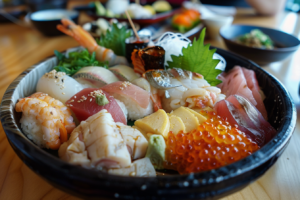Japanese sushi stands as a globally recognized culinary marvel, symbolizing much more than mere food—it embodies an art form steeped in tradition and precision. Rooted deeply in Japanese culture, sushi merges aesthetics with flavor, creating an eating experience that is both simple and sophisticated. This introductory guide delves into the essence of sushi, exploring its components, variations, and the cultural significance that has made it a beloved dish worldwide.
Origins and Evolution of Japanese Sushi
The concept of Japanese Sushi originated from a practical need to preserve fish. The technique started with fermenting fish in rice, where the rice was discarded, and only the fish was eaten. However, over the centuries, this method evolved significantly. By the Edo period (1603-1868) in Japan, sushi had transformed into something similar to what we enjoy today—vinegared rice paired with fresh fish, consumed together.
Key Ingredients in Sushi
At its core, Japanese Sushi is characterized by its simplicity. The main ingredients include:
- Sushi Rice (Shari): This is short-grain rice mixed with a blend of vinegar, sugar, and salt. The rice must be cooled to just the right temperature before it’s ready to be paired with other ingredients.
- Nori (Seaweed): Used primarily in rolled sushi (maki), nori acts as a wrapper that holds the sushi ingredients together.
- Fish: Typically, sushi uses raw fish like salmon, tuna, and mackerel. The fish must be of the highest quality, often termed ‘sushi-grade’ to ensure freshness and safety.
- Other Ingredients: Besides fish, sushi can include a variety of ingredients such as vegetables (e.g., cucumber, avocado), tropical fruits, and sometimes even meats like beef or chicken.
Types of Japanese Sushi
There are several types of Japanese Sushi , each offering a different experience:
- Nigiri: A slice of raw fish atop a mound of pressed vinegared rice.
- Maki: Rolled sushi with seaweed on the outside.
- Temaki: Sushi that’s rolled into a cone shape, resembling a hand roll.
- Sashimi: Though not technically sushi since it doesn’t include rice, sashimi consists of thin slices of raw fish and is often enjoyed alongside sushi dishes.
Cultural Impact
Japanese Sushi is not just food; it’s a cultural statement. In Japan, it is associated with special occasions and is often consumed during celebrations. Its global spread has made it a popular choice in restaurants worldwide, introducing people to Japanese flavors and eating customs.
Conclusion
Sushi is a fascinating culinary art that offers a unique blend of taste, tradition, and innovation. Whether you’re enjoying a simple maki roll or indulging in an elaborate nigiri piece, sushi provides a gateway to understanding Japanese culture and gastronomic finesse.
Traditional Japanese Sushi Recipe
Sushi, a renowned Japanese dish, is celebrated globally for its elegant simplicity. This guide will walk you through making basic sushi at home, focusing on nigiri and maki, which are among the most beloved varieties.
Ingredients for Japanese Sushi Rice:
- Begin with 2 cups of sushi or short grain rice.
- Measure 2 cups of water, keeping extra on hand for rinsing the rice.
- Mix in 2 tablespoons of rice vinegar.
- Add 2 tablespoons of sugar.
- Incorporate 1 tablespoon of salt to enhance the flavor.
Nigiri and Maki Fillings:
Wasabi
Equipment:
Rice cooker or pot
Bamboo sushi mat (for maki rolls)
Sharp knife
Instructions:
Prepare the Fillings:
Place the slice of fish over the rice mound and gently press it around the rice.
Assemble the Maki:
Set a sheet of nori on a bamboo sushi rolling mat.Spread an even layer of sushi rice on the nori, covering about 2/3 of the sheet closest to you.Lay your fillings along the center of the rice-covered part.Begin rolling using the bamboo mat to keep the roll tight. Lift the edge of the mat over the roll, squeezing gently but firmly.Continue rolling until the edges are sealed, and the roll is firm.
Cutting the Rolls:
Wet a sharp knife with water and vinegar. This helps to prevent sticking.Slice the roll into six or eight pieces, depending on your preference.
Serving:Serve the sushi with soy sauce, pickled ginger, and a small dab of wasabi.Making sushi at home can be a delightful experience, giving you the freedom to experiment with different fillings and flavors. Enjoy the freshness of homemade sushi and the satisfaction of creating something truly special with your own hands!
Common Missteps to Avoid When Eating Japanese Sushi
Sushi is a sophisticated and refined culinary experience, and enjoying it the right way can significantly enhance your dining pleasure. However, there are several common errors that diners might unknowingly make when eating Japan sushi. Avoiding these missteps can lead to a more authentic and enjoyable sushi experience.
Using Too Much Soy Sauce
One of the most frequent mistakes is overusing soy sauce. Dipping sushi heavily into soy sauce can overpower the delicate flavors of the fish and rice. Ideally, only the fish part of the sushi should be lightly touched to the soy sauce, not the rice, as the rice can absorb too much sauce and alter the intended flavor balance created by the sushi chef.
Mixing Wasabi Directly Into Soy Sauce
While it might seem practical or commonplace to mix wasabi into the soy sauce, this practice is generally frowned upon in traditional Japanese dining. The correct method is to place a small amount of wasabi directly on the sushi piece before lightly dipping it into soy sauce. This approach respects the individual flavors of the wasabi and soy sauce without overwhelming the sushi’s taste.
Not Eating the Sushi in One Bite
Sushi is typically crafted to be consumed in a single bite. Eating a sushi piece in multiple bites can disrupt the intended flavor profile and texture experience designed by the chef. If the sushi piece seems too large, it is acceptable to ask the chef to make smaller pieces.
Ignoring the Order of Sushi Served
There is often a recommended sequence for eating Japan sushi, typically starting with lighter, more delicate flavors and progressing towards heavier, more flavorful varieties. This order enhances your ability to appreciate the subtleties of each type. If you ignore this sequence, you might experience a less harmonious culinary journey.
Not Using Ginger Appropriately
Ginger serves to refresh the palate between different sushi varieties. You should eat it not with the sushi, but between pieces to refresh your taste buds and prepare them for a new flavor. If you eat ginger incorrectly, it can disrupt the flavor experience of your sushi.
Overlooking the Chef’s Recommendations
If you’re dining at a sushi bar, paying attention to the chef’s recommendations can greatly enhance your experience. The sushi chef is an expert in his craft and can suggest the best pieces based on what’s freshest that day. Ignoring these recommendations might mean missing out on the best the restaurant has to offer.
Disrespecting Sushi Etiquette
While not strictly related to taste, following proper sushi etiquette shows respect for the chef and the culinary art of sushi making. This includes behaviors such as avoiding the rubbing of your chopsticks together, which can seem like an insult implying the chopsticks are cheap, and placing them correctly on the chopstick rest when not in use.
By avoiding these common errors, you can respect the tradition and skill that go into preparing sushi, enhancing your overall enjoyment of this exquisite Japanese cuisine.
Nutritional Benefits of Eating Sushi
Sushi is a low-calorie option that combines simple, wholesome ingredients such as rice, fish, and vegetables. This composition makes sushi a beneficial part of a balanced diet.

Health Aspects of Sushi Ingredients
Omega-3 Fatty Acids:
Many types of fish commonly used in sushi, such as salmon and tuna, are rich sources of omega-3 fatty acids. These essential nutrients significantly help improve heart health by reducing blood pressure and lowering cholesterol levels. Consequently, they are vital for cardiovascular wellness.
Protein:
Additionally, sushi offers a good source of lean protein from fish, which is crucial for muscle repair and growth. This protein content not only helps sustain energy but also supports metabolic processes, thereby making sushi an excellent choice for maintaining overall health and fitness.
Rice:
Furthermore, the sushi rice, seasoned with vinegar, adds a unique flavor and offers some digestive benefits. As a source of carbohydrates, the moderate portion size in sushi helps maintain energy levels without leading to excessive calorie intake, thus balancing taste and health effectively.
Seaweed:
Ginger and Wasabi:
FAQs About Japan Sushi
How to Make Sushi Rice ?
Making sushi rice involves more than just cooking rice; it requires careful seasoning to achieve the perfect balance of flavor and stickiness essential for good sushi. Here’s how to do it:
- Rinse the Rice: Start by rinsing short-grain sushi rice under cold water until the water runs clear. This process eliminates extra starch, helping to keep the rice from getting overly sticky.
- Cook the Rice: Cook the rice according to package instructions, typically with a ratio of 1 part rice to 1.2 parts water.
- Prepare Sushi Vinegar: While the rice is cooking, mix rice vinegar, sugar, and salt in a saucepan. Warm the mixture gently until the sugar dissolves, but be sure not to bring it to a boil.
- Season the Rice: Once the rice is cooked, transfer it to a wide bowl (preferably wooden, such as a Hangiri). Slowly pour the sushi vinegar over the rice while using a rice paddle or a wooden spoon to fold the rice gently. Be careful not to smash the grains.
- Cool the Rice: Fan the rice as you mix it to help it cool quickly and give it a nice shine. The rice should be room temperature when you’re ready to make sushi.
Is Japanese Sushi Cheaper in Japan?
Is Sushi Gluten-Free?
Sushi can be gluten-free, but it depends on the ingredients used. Sushi rice and raw fish are naturally gluten-free; however, many sushi items include sauces and marinades containing gluten, such as soy sauce and teriyaki sauce. To ensure a gluten-free meal, opt for sushi made without these sauces or ask for gluten-free alternatives.
How Long Does Japanese Sushi Last in the Fridge?
You should enjoy sushi fresh, but if you need to store it, place it in the refrigerator and aim to consume it within 24 hours. You should not keep sushi containing raw fish for more than a day, as it can spoil quickly. However, sushi made with cooked ingredients or vegetables can last up to 48 hours. Always ensure to check for freshness before consuming it.
Here are some existing articles that could potentially be used for internal linking if an article about Japanese Sushi is created:
Easy Mochi Cake Recipe– Link this article by highlighting mochi as a popular Japanese dessert, offering a cultural or thematic connection to Japanese cuisine.
Ultimate Guide to Chicken Cutlet Recipes– Include this to discuss another beloved dish in Japan, chicken katsu, alongside Traditional sushi.
Chocolate Mousse Cake Recipe & Tips Use this to compare Western and Japanese dessert techniques and preferences, showcasing the differences.
Almond Croissant Recipe Guide – This article could discuss the fusion of cuisines and the influence of other culinary traditions on Japanese baking.
Conclusion about Japanese Sushi
These FAQs address some of the common questions related to Japan sushi , providing useful tips and important considerations for sushi enthusiasts looking to deepen their understanding and enjoyment of this iconic Japanese dish. Learn more about Homemade Sushi here.


